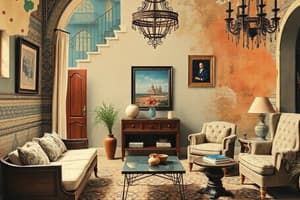Podcast
Questions and Answers
ما هي المواد التي غالبًا ما تُستخدم في صنع الأثاث الفاخر؟
ما هي المواد التي غالبًا ما تُستخدم في صنع الأثاث الفاخر؟
- البلاستيك
- الحرير أو المخمل أو الصوف (correct)
- الخشب
- المعادن
الأثاث الفاخر لا يتضمن ألوانًا جريئة مثل الأزرق.
الأثاث الفاخر لا يتضمن ألوانًا جريئة مثل الأزرق.
False (B)
ما هي الصفة التي تُوصف بها الألوان المستخدمة في الأثاث الفاخر?
ما هي الصفة التي تُوصف بها الألوان المستخدمة في الأثاث الفاخر?
غنية وجريئة
غالبًا ما يكون الأثاث الفاخر __________.
غالبًا ما يكون الأثاث الفاخر __________.
قم بمطابقة المواد مع خصائصها:
قم بمطابقة المواد مع خصائصها:
ما الذي يضيف لمسة من الفخامة والدفء إلى المكان؟
ما الذي يضيف لمسة من الفخامة والدفء إلى المكان؟
الصحاري الرملية تعكس جمال الطبيعة المغربية.
الصحاري الرملية تعكس جمال الطبيعة المغربية.
اذكر عنصر من عناصر التزيين التي تعتبر جزءاً من الثقافة المغربية.
اذكر عنصر من عناصر التزيين التي تعتبر جزءاً من الثقافة المغربية.
السجاد المغربي الشهير يضيف لمسة من الفخامة والدفء إلى ______.
السجاد المغربي الشهير يضيف لمسة من الفخامة والدفء إلى ______.
طابق بين العناصر التالية ودورها في الثقافة المغربية:
طابق بين العناصر التالية ودورها في الثقافة المغربية:
Flashcards
Fabric Types
Fabric Types
Rich fabrics like silk, velvet, and wool are often used.
Color
Color
Colors are often bold and rich, like blue.
Placement
Placement
These fabrics are usually placed on the ground, such as sofas.
Low Profile
Low Profile
Signup and view all the flashcards
Rich Aesthetics
Rich Aesthetics
Signup and view all the flashcards
Moroccan Rugs
Moroccan Rugs
Signup and view all the flashcards
Blue Sky
Blue Sky
Signup and view all the flashcards
Desert Sands
Desert Sands
Signup and view all the flashcards
Water Features
Water Features
Signup and view all the flashcards
Moroccan Design
Moroccan Design
Signup and view all the flashcards
Study Notes
Recent Trends in Interior Design
- Interior design trends are constantly evolving.
- Moroccan, Indian, and Chinese interior design styles are popular.
The Basics of Moroccan Interior Design
- Moroccan interior design blends diverse cultural influences (Berbers, Jews, Arabs, Mediterranean).
- It gained popularity in the 1960s after European tourists discovered and purchased Moroccan goods.
- A key figure in popularizing Moroccan design was Yves Saint Laurent.
- It's a type of Islamic interior design with shared characteristics like vibrant colours, Islamic arches, geometric patterns, floor seating, low platforms, and layered rugs.
The Basics of Moroccan Interior Design (cont.)
- It's a blend of authenticity, luxury, and simplicity.
- Traditional furniture, often low to the ground (sofas, large cushions), creates a comfortable environment.
- Ornate fabrics (silk, velvet, wool, cotton) with traditional embroidery, zellige patterns, and geometric motifs are prominent.
- Famous Moroccan rugs add luxury and warmth.
- Bold colors (turquoise blue, emerald green, crimson red, gold) reflect the Moroccan landscape.
- Water features (fountains) are visually appealing and create a sense of tranquility.
The Basics of Indian Interior Design
- Indian interior design reflects India's rich history and culture.
- It's multicultural, with a blend of modern urban life and spirituality.
- Vibrant colors (purple, orange, gold, red, emerald) are common.
- Furniture is often carved wood, inlaid with precious materials (pearls, ivory, stone, or metal).
- Decorative arts, religious idols, and statues are important elements.
- Natural elements (water features, plants, jasmine, lotus flowers) are commonplace.
The Basics of Indian Interior Design (cont.)
- Furnishings are often kept to a minimum to avoid clutter.
- The focus is on comfort and aesthetic appeal.
- Embroidered fabrics (saris, Indian rugs) are used extensively for upholstery, curtains, and rugs.
- Vibrant colors (orange, red, blue, green) inspire joy and energy in interior spaces.
- Wood and precious materials add elegance and warmth to the design.
The Basics of Chinese Interior Design
- Chinese interior design is thousands of years old, rooted in balance and harmony.
- Confucian and Taoist philosophies greatly influence its principles.
- Natural materials (wood, stone) are utilized.
- Significant colors (red = luck, yellow = power and royalty) are part of the design.
- The "Feng Shui" concept plays a crucial role in arranging furniture for positive energy flow.
- Decorative elements (dragons, phoenixes, ancient calligraphy) are important aesthetic components.
- The design emphasizes harmony between humans and nature.
- Furnishings (chairs, tables) are often made of dark wood, such as rosewood or teak. These are often simple in shape but elaborately decorated in a stylized way.
- Natural motifs (flowers, birds) are present.
- The style aims for serene, ordered, and comfortable spaces.
Studying That Suits You
Use AI to generate personalized quizzes and flashcards to suit your learning preferences.
Related Documents
Description
يتناول هذا الاختبار أساسيات التصميم الداخلي المغربي وتنوع أنماطه الثقافية. سوف تستكشف تأثيرات الشعوب المختلفة على التصاميم، وأهمية الأثاث التقليدي والألوان الزاهية في إنشاء بيئة مريحة. انضم لاختبار معرفتك!




